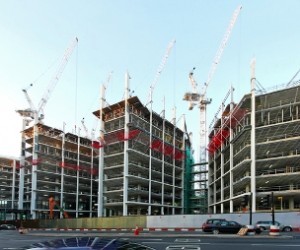Mayor consults on London construction dust guidance
Views being sought by the Mayor on draft guidance for limiting dust emissions from construction sites in the capital
Draft supplementary guidance (SPG) on the control of dust and emissions during construction and demolition has been published for consultation by the London Mayor Boris Johnson.
The draft guidance focuses on reducing emissions of particulate matter PM2.5 and PM10 as well as nitrogen dioxide from construction sites and includes recommendations for cleaner construction machinery.

Guidance on limiting air pollution from construction sites in the capital is being consulted on by the London Mayor
The Mayor is inviting comments on the guidance during the 12-week consultation, which began last month, by post and email until 6pm on November 25 2013.
The guidance sets out that local planning authorities should secure an air quality statement from developers, providing specific instructions on how to safely perform a construction or demolition-related task.
As part of the air quality statement, the guidance states that developers should produce a dust risk assessment, which takes into account national and European air quality objectives and identifies suitable mitigation measures.
It adds that the risk assessment should also be reviewed by the local planning authority and identify whether on-site activity represents a low, medium or high risk.
Essential
Furthermore, the guidance states that all demolition and construction sites should be monitored for the generation of air pollution. According to the document, it is ‘essential’ to monitor for PM10, while the need to monitor PM2.5 and nitrogen dioxide will be determined on a case by case basis by the planning authority.
Commenting on the draft guidance, Mr Johnson said: “This supplementary planning guidance builds on the voluntary guidance published in 2006. It incorporates more detailed guidance and best practice, and for the first time, seeks to address emissions from construction machinery through a low emission zone for non-road mobile machinery which is to be introduced in 2015.”
According to the Mayor, construction sites were responsible for around 12% of London’s nitrogen oxide emissions.
Developed in partnership with industry, the SPG provides guidance for the implementation of air quality policies in the London Plan on:
- the preparation of an Air Quality Statement for construction and demolition activities, including air quality (dust) risk assessments;
- the stages of development the Air Quality Statement is to cover, that is for demolition, earthwork, construction stages and trackout (vehicles leaving the site) stages of the works;
- the identification of the potential scale (large, medium, small) of dust emissions for each stage of work;
- the identification of the level of risk due to the scale of dust emissions on health, soiling (dirt) and the natural environment, depending on activities, their intensity and the sensitivity of receptors;
- best practice methods for controlling dust on-site and to prevent trackout;
recommendations for monitoring; - early notification of new 2015 and 2020 standards for non-road mobile machinery.
Mr Johnson revealed plans for new guidance and a low emission zone for construction machinery as part of a raft of air quality measures in February (see airqualitynews.com story).
The Mayor also said he would work with the Environment Agency to rollout the use of dust suppressants at industrial sites, which he said had reduced concentrations of particulate matter PM10 emissions by up to 59% at a site in the capital on Horn Lane.
More information on the consultation is available on the Greater London Authority website.















